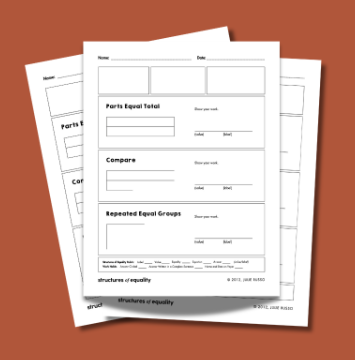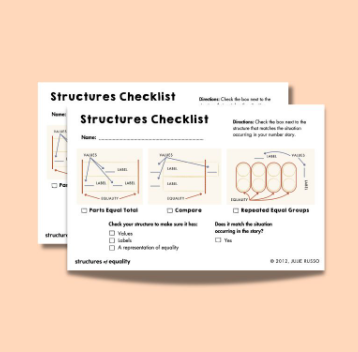October 9, 2024
Assessment
With all the pressure to make sure your students meet math proficiency, it’s easy to get overwhelmed. Many teachers I talk to mention the high-stakes testing culture in their buildings and districts. They often get pressured to skip things like formative assessments and focus on longer, multiple choice tests to help kids “get ready”.
Today, I’ll cover:
- the difference between formative and summative assessments
- why math formative assessments are important
- types of formative assessments
- how to use formative assessments effectively
- formative assessments you can use with Structures of Equality (SoE)
The difference between formative and summative assessments
Formative, summative, authentic, diagnostic… There are so many different types of assessment. Even though we’re only talking about formative assessments today, the distinction is important.
What is formative assessment?
“Formative assessment is a planned, ongoing process used by all students and teachers during learning and teaching to elicit and use evidence of student learning to improve student understanding of intended disciplinary learning outcomes and support students to become self-directed learners.” (CCSO)
Notice the root word ‘form’ in formative. This is a low-stakes assessment method used to inform your instruction. It can include teacher, peer, and self-assessment.
Rather than waiting to see if students have mastered a concept at the end of a unit, formative assessment helps us see what they know and understand during the learning process. It provides us with the information we need to adjust our instruction, and gives students the information they need to know what areas they have for growth.
What is summative assessment?
At the end of a unit, we generally measure a student’s understanding of the content with a comprehensive test. The goal is to evaluate their knowledge and skills once they’ve completed the learning tasks.
Notice the word ‘sum’ in summative. These tend to be higher-stakes tests used for evaluation and grading purposes.
While they both have their place, I’d argue that formative assessment is even more important.
Why math formative math assessments are important
Formative assessments are non-negotiable if we want to maximize student learning. It’s like going to the doctor for a check-up. When done regularly, you can catch potential health concerns easily and begin preventative or early treatment. With formative assessments, you find misconceptions or gaps you can address before they become bigger issues.
If you’ve ever been on the receiving end of a negative performance report or evaluation, you’ve probably thought “It would have been helpful to know this before. I could’ve worked on it.” It’s the same with our students. Sometimes students aren’t aware of what they don’t understand, or they are but don’t know how to fix it.
Formative assessments help us course correct before we get way off track. This leads to greater understanding, and ultimately, higher math proficiency.
Types of formative assessments
Formative assessments seamlessly fit into our daily instruction. They can be as simple as thumbs up/thumbs down or an exit ticket.
I talk to a lot of teachers who are overwhelmed by exit tickets. Here are some strategies you can use to make them low effort/high reward. At the end of class, allow about 3-5 minutes for students to work through one problem tied directly to your learning goal for the day. Ideally, you’ll have worked the problem out ahead of time and know exactly what you’re looking for to see if students know and understand the objective.
You can set up 3 separate baskets – red, yellow, and green – for them to turn in their work when they’re done. If they feel confident about their work and solution, it goes in the green basket. If they’re unsure and might need help, it goes in the yellow basket. It goes in red if they need additional support.

Then, you can go through and check to see how they self-assessed.. You’ll find they tend to self-assess well, especially after they’ve done it a few times. Take note of any that should be in a different category and place them in the other pile. These are students you may want to have a quick conference the next day.
If most of your students grasped the concept, this tells you not to spend too much time on it and you can move on. If most of them need additional support, look for trends and patterns with their misconceptions. Use these to guide a quick check-in the next day or make adjustments to your instruction.
You can find more formative assessment examples here, along with descriptions. I especially like the section about homework.
Another effective tool is a rubric or checklist students are familiar with. This can be used for teacher, peer, or self-assessment. I’ll talk about this more below.
How to use formative assessments effectively
In addition to ideas mentioned previously, here are a few important ideas to note:
- Formative assessments are check-ins and should not be graded. They are meant to assess throughout the teaching of a skill or strategy so you can stop and make corrections before layering on more concepts.
- Don’t keep them a secret from your students! You’ll find they’re motivated when they get timely feedback. When kids know exactly what to work on, they’re less likely to get frustrated and give up.
- Tie them to clear objectives. Let students know what you want them to know and do and make sure your formative assessment aligns to that goal.
- Set the purpose with your students. Let them know the purpose is to help them grow. Sometimes they need to hear that you’d rather see inaccurate work than no work at all.
Using formative assessments with Structures of Equality (SoE)
If you’re new to SoE or haven’t implemented it yet, you may want to get started with this introduction. Whenever I provide professional development for those starting out, I emphasize that SoE is a long game. There’s no quick fix for getting your kids to truly understand and feel confident when working with number stories. It’s often a new way of thinking for students (and teachers) and takes time to internalize.
Monitoring and assessing problem solving and critical thinking skills is no easy task. Part of implementation includes discussion and justifying thinking. This helps you see and hear what misconceptions your students may have. But sometimes it’s nice to have a quick paper and pencil task for them to complete too.


Once your students have had exposure to the structures and practiced them for a little while, you can provide this work mat for a quick check. I created a brief video that explains how to use it. Based on teacher feedback, I now have a checklist perfect for teacher, peer, or self-assessment. The work mat and checklist work best when you’ve modeled how to use them during whole class instruction.
Conclusion
Incorporating formative assessments into your math instruction is beneficial to you and your students. By regularly checking in and adjusting your teaching, you can address gaps before they widen. If you’re not already, I urge you to think about how you can begin incorporating formative assessments to guide your instruction and increase student achievement. When you make regular formative assessment a part of your practice, summative assessments feel a lot less intimidating.